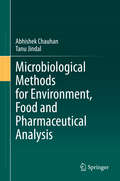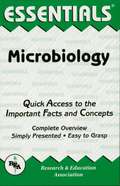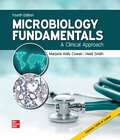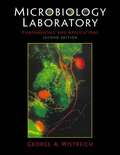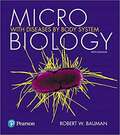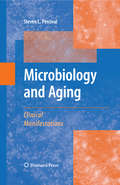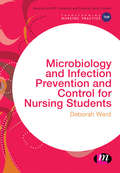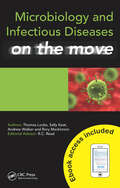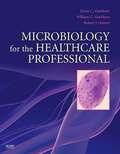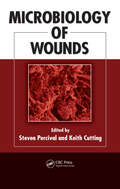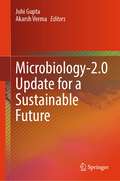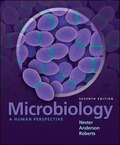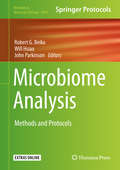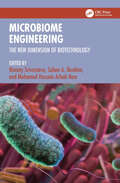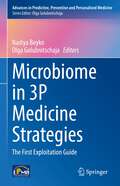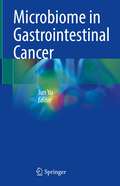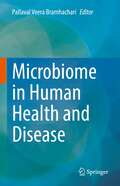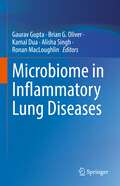- Table View
- List View
Microbiological Contamination Control in Pharmaceutical Clean Rooms
by Nigel HallsContamination control in pharmaceutical clean rooms has developed from a jumble of science and engineering, knowledge of what has worked well or badly in the past, dependent upon the technology available at the time the clean room was built and subsequent technological developments. Surrounding it all is a blanket of regulations. Taking a multidisc
Microbiological Corrosion of Buildings: A Guide to Detection, Health Hazards, and Mitigation (Occupational Safety, Health, and Ergonomics)
by Rafał L. GórnyEnvironmental stress caused by water continuously exposes buildings to microbial colonization. This is highly evident when both minor dampness and mass flooding occur. The text describes how microbiological corrosion of buildings and the structures and substances derived from these hazards are responsible for adverse health effects on people exposed to these contaminated environments. Microbiological Corrosion of Buildings: A Guide to Detection, Health Hazards, and Mitigation describes the key elements and methods for neutralising and removing microbiological contamination, and the operating algorithm for checking the effectiveness of preventative solutions. Ideal for construction engineers, microbiologists and professionals in the field. Features: Latest methods for detection of indoor microbial hazards Identifies the tools needed for natural, non-destructive and non-invasive methods of bio-corrosion removal Describes the social and health problems associated with exposure to microbiological hazards Provides case studies and examples of microorganisms responsible for microbial corrosion. ‘Climate change and the associated adverse effects, such as floods and whirlwinds, make the problem of microbiological corrosion of buildings that generates health risks and economic losses on a global scale, the focus of science and technology. The monograph presents a complex problem of building bio-corrosion, that requires knowledge of the distant fields of microbiology and building technology, for the use of both scientists and practitioners. This pioneering work of an interdisciplinary nature harmoniously combines knowledge on specific microbiological issues relating to the process of bio-corrosion and the associated health risks with detailed issues of construction technology concerning the prevention of bio-corrosion and its removal. The authors succeeded in combining a very high scientific level in the monograph with an accessible and understandable presentation of complex problems. The extensive references, ranging from "classical" items from many years ago to the most recent articles presenting the state of the art in this field, are worth emphasising.’ —Prof. Jacek Dutkiewicz, Ph.D., D.Sc., Institute of Rural Health in Lublin
Microbiological Methods for Environment, Food and Pharmaceutical Analysis
by Tanu Jindal Abhishek ChauhanThis book provides a broad account of various applied aspects of microbiology for quality and safety evaluations in food, water, soil, environment and pharmaceutical sciences. The work is timely, as the safety and quality of various commodities such as water and wastewater, food, pharmaceutical medications and medical devices are of paramount concern in developing countries globally for improved public health quality in areas ranging from food security to disease exposure. The book offers an introduction to basic concepts of biosafety and related microbiological practices and applies these methodologies to a multitude of disciplines in subject-focused chapters. Each chapter offers experiments and exercises pertaining to the specific area of interest in microbiological research, which will allow readers to apply the knowledge gained in a laboratory or classroom setting to see the microbiological methods discussed in practice. The book will be useful for industrialists, researchers, academics and undergraduate/graduate students of microbiology, biotechnology, botany and pharmaceutical sciences. The text aims to be a significant contribution in effectively guiding scientists, analysts, lab technicians and quality managers working with microbiology in industrial and commercial fields.
Microbiology Essentials (Essentials Study Guides)
by Tammy Mccormick Lauren GrossREA's Essentials provide quick and easy access to critical information in a variety of different fields, ranging from the most basic to the most advanced. As its name implies, these concise, comprehensive study guides summarize the essentials of the field covered. Essentials are helpful when preparing for exams, doing homework and will remain a lasting reference source for students, teachers, and professionals. Microbiology includes the history of microbiology, equipment and techniques, diversity of microorganisms, genetics, metabolism, transport of molecules, role of microbes in disease, microbes in the environment, and microbes in industry.
Microbiology For Veterinary Technicians
by Tracy Vemulapalli G. HammacMicrobiology for Veterinary Technicians introduces veterinary technician and technologist students to the complex and exciting world of microorganisms. Divided into four main parts, the book provides pertinent, up-to-date information regarding many different aspects of veterinary microbiology.
Microbiology Fundamentals: A Clinical Approach
by Heidi Smith Marjorie Kelly Cowan Jennifer LuskCowan's Microbiology Fundamentals: A Clinical Approachis a perfect fit for your microbiology course. The author team includes a practicing Registered Nurse who shows students how the content on each page relates to their lives and future career. McGraw Hill Connect® is aligned with the text and provides a highly reliable, easy-to-use homework and learning management solution that embeds learning science and award-winning adaptive tools to improve student results.
Microbiology Laboratory Fundamentals and Applications
by George A. WistreichThis comprehensive laboratory manual provides state-of-the-art techniques, concepts, and applications of microbiology. The overall approach is designed to start with basic concepts and procedures and to gradually build more advanced levels, strengthening readers' understanding and skills through the process. An invaluable reference as a refresher of basic concepts, techniques and procedures. Current, thorough coverage of topics including, but not limited to: cultivation techniques; microbial genetics; immunology; and medical microbiology. For laboratory technicians and medical laboratory technologists.
Microbiology With Diseases By Body System
by Robert BaumanKEY MESSAGE: Designed for pre-nursing and allied health readers, Microbiology with Diseases by Body System, 2/eretains the hallmark art program and clear writing style that have made Robert Bauman's book a success. Filled with intriguing content based on cutting-edge research that engages readers, the Second Edition features increased clinical coverage as well as a strong focus on the beneficial effects of microbes. Media Manager 2.1 provides instructors with the most robust media program available in the microbiology market for dynamic classroom presentations. In addition to all of the art, photos, and tables from the book in JPEG or PowerPoint format and customizable PowerPointlecture outlines, Media Manager 2.1 also includes 115 brief animations that depict complex microbial processes. These animations also appear on The Microbiology Place Website, with quizzes, for readers. <P><P>KEY TOPICS: A Brief History of Microbiology, The Chemistry of Microbiology, Cell Structure and Function, Microscopy, Staining, and Classification, Microbial Metabolism, Microbial Nutrition and Growth, Microbial Genetics, Recombinant DNA Technology, Controlling Microbial Growth in the Environment, Controlling Microbial Growth in the Body: Antimicrobial Drugs, Characterizing and Classifying Prokaryotes, Characterizing and Classifying Eukaryotes, Characterizing and Classifying Viruses, Viroids, and Prions, Infection, Infectious Diseases, and Epidemiology, Innate Immunity, Adaptive Immunity, Immunization and Immune Testing, AIDS and Other Immune Disorders, Microbial Diseases of the Skin and Wounds, Microbial Diseases of the Nervous System and Eyes, Microbial Cardiovascular and Systemic Diseases, Microbial Diseases of the Respiratory System, Microbial Diseases of the Digestive System, Microbial Diseases of the Urinary and Reproductive Systems, Applied and Environmental Microbiology. MARKET: For all readers interested in microbiology.
Microbiology and Aging
by Steven L. PercivalThe microbiological burden on an aging host is enormous, and clinically significant. As humans are living longer there is a greater propensity to infection. This risk is substantially heightened in elderly individuals who are predisposed to infection. Do the microbiological changes that occur within and upon the host influence the process of ageing or is it the biological changes of the host that affects the host's microbiology? Do such changes therefore affect the host's propensity to disease? Are there ways of enhancing life expectancy by reducing certain bacteria from proliferating or conversely by enhancing the survival of beneficial bacteria? Microbiology & Aging: Clinical Manifestations encompasses a collection of reviews that highlight the significance of, and the crucial role, that microorganisms play in the human life cycle and considers the microbiology of the host in different regions of the body during the aging process.
Microbiology and Infection Prevention and Control for Nursing Students (Transforming Nursing Practice Series)
by Deborah WardPreventing and controlling infection has long been an on going challenge for all healthcare workers at every level. High profile examples like the Ebola outbreak in West Africa or the prevalence of ‘super bugs’ like MRSA demonstrate that this challenge is not going to go away. As a nurse you have a responsibility to protect your patients from harm and preventing and controlling infection is a crucial component of this. By introducing the unpinning microbiology to explain how infection occurs and spreads and the practical steps and precautions that you need to follow, this book will equip you with the knowledge and information necessary to play your part in preventing and controlling infection. Key features: · Written specifically for pre-registration nursing students providing the core, evidence-based knowledge that you need to know · Breaks the science down using easy-to-follow language, practical examples and case studies · Applies microbiology to practice introducing practical steps, precautions and strategies that will benefit you as soon as you get onto your placements · Includes multiple-choice questions to test your understanding and activities to help you engage with wider issues around infection prevention and control. About the author Deborah Ward is a lecturer at the School of Nursing, Midwifery and Social Work, Manchester University.
Microbiology and Infection Prevention and Control for Nursing Students (Transforming Nursing Practice Series)
by Deborah WardPreventing and controlling infection has long been an on going challenge for all healthcare workers at every level. High profile examples like the Ebola outbreak in West Africa or the prevalence of ‘super bugs’ like MRSA demonstrate that this challenge is not going to go away. As a nurse you have a responsibility to protect your patients from harm and preventing and controlling infection is a crucial component of this. By introducing the unpinning microbiology to explain how infection occurs and spreads and the practical steps and precautions that you need to follow, this book will equip you with the knowledge and information necessary to play your part in preventing and controlling infection. Key features: · Written specifically for pre-registration nursing students providing the core, evidence-based knowledge that you need to know · Breaks the science down using easy-to-follow language, practical examples and case studies · Applies microbiology to practice introducing practical steps, precautions and strategies that will benefit you as soon as you get onto your placements · Includes multiple-choice questions to test your understanding and activities to help you engage with wider issues around infection prevention and control. About the author Deborah Ward is a lecturer at the School of Nursing, Midwifery and Social Work, Manchester University.
Microbiology and Infectious Diseases on the Move
by Andrew Walker Thomas Locke Sally Keat Rory MackinnonThe Medicine on the Move series provides fully flexible access to subjects across the curriculum in a unique combination of print and mobile formats ideal for the busy medical student and junior doctor. No matter what your learning style, whether you are studying a subject for the first time or revisiting it during exam preparation, Medicine on the
Microbiology for Surgical Technologists
by Margaret H. Manning RodriguezPart of a crucial foundation for perioperative care, MICROBIOLOGY FOR SURGICAL TECHNOLOGISTS, 2nd Edition helps surgical technology students understand and prevent disease transmission in clinical settings. In addition to exploring the vast microbial world, learners investigate the infectious disease process and disease pathologies, correlating them with anatomical body systems. Health and safety procedures are important topics, with key procedures for protecting patients, team members, and the students themselves. MICROBIOLOGY FOR SURGICAL TECHNOLOGISTS, 2nd Edition is also packed with helpful extras, including colorful photos, realistic case studies, end-of-chapter questions, and special boxed features that call out interesting facts and anecdotes to highlight the importance of aseptic and sterile techniques in every surgical intervention.
Microbiology for the Healthcare Professional
by Karin C. Vanmeter Robert J. Hubert William G. VanmeterTextbook on the spread, control, and prevention of infectious diseases for healthcare professionals and students. General concepts within the life sciences are covered, followed by chapters that apply these concepts to the life science/health field and infections in each body system. Concluding topics include the immune system, pharmacology, antimicrobial drugs, microorganisms and different age groups, the environment, and biotechnology.
Microbiology in the Era of Artificial Intelligence: Nanotechnology, Quantum, and Next Generation Sequencing
by Muhammad Ali Syed Shahzad Ali Tanveer HussainWritten by leading experts, the book covers a broad range of topics pertaining to the myriad uses of artificial intelligence in microbiology. The book explores how AI and computation can play a key role in understanding and uncovering microscopic mysteries that defy other means of microbiological study. Like other fields of life science, the impact of next generation sequencing and bioinformatics are revolutionizing microbiology. In addition, the emerging role of quantum and nanotechnology in understanding the nature of microbial life is also explored. A special feature of the book is fascinating discussion of the transformation currently underway from classic microbiology to next generation microbiology. This is a must-read book for microbiology students and researchers who want to be at the forefront of this exciting field.Key Features:• Provides an overview and perspectives on the future of microbiology• Documents recent advances in microbiology• Contributions from an international team of leading researchers• Reviews the emerging role of applications from other fields like nanotechnology, artificial intelligence, and genomics• Stimulates academics and researchers to pursue multidisciplinary research
Microbiology of Wounds
by Steven Percival Keith CuttingIt is not the presence of microorganisms, but their interaction with patients that determines their influence on wound healing. Documenting this critical but often ignored aspect of the treatment process, Microbiology of Wounds discusses the microbiology and biology of human wounds in relation to infection and non-healing. Gain the Necessary Scient
Microbiology-2.0 Update for a Sustainable Future
by Akarsh Verma Juhi GuptaThis book demonstrates the extremely fascinating and interdisciplinary microbial domain. It helps in discovering the latest advances in microbiology and learns how they can help shape a more sustainable future for our planet. This comprehensive guide covers the latest breakthroughs in microbiology research and their practical applications in fields such as ecology, agriculture, biotechnology, and environmental science. Furthermore, the readers explore the cutting-edge technologies and methodologies that are driving the next generation of microbiology research. With expert insights from the leading microbiologists, this book is an essential resource for anyone interested in understanding the role of microbes in our world and harnessing their power for a better tomorrow.
Microbiology: A Human Perspective
by Eugene Nester Denise Anderson C. RobertsPerfect for the non-major/allied health student (and also appropriate for mixed majors courses), this text provides a rock solid foundation in microbiology. By carefully and clearly explaining the fundamental concepts and offering vivid and appealing instructional art, "Microbiology: A Human Perspective" draws students back to their book again and again The text has a concise and readable style, covers the most current concepts, and gives students the knowledge and mastery necessary to understand advances of the future. A body systems approach is used in the coverage of diseases.
Microbiology: Laboratory Theory And Application
by Michael Leboffe Burton PierceThis manual is appropriate for courses populated primarily by allied health students or for courses where an abbreviated number of experiments is preferred. This new edition has been carefully revised to provide increased clarity, better organization, and improvements to its already unsurpassed photography and artwork. These features have made this manual and its associated title, "Microbiology: Laboratory Theory & Application, 4e", the best-selling microbiology lab manual series on the market.
Microbiome Analysis: Methods And Protocols (Methods in Molecular Biology #1849)
by John Parkinson Robert G. Beiko Will HsiaoThis volume aims to capture the entire microbiome analysis pipeline, sample collection, quality assurance, and computational analysis of the resulting data. Chapters detail several example applications of microbiome research, and the protocols described in this book are complemented with short perspectives about the history, current state, and future directions of protocols in microbiomics. Written in the highly successful Methods in Molecular Biology series format, chapters include introductions to their respective topics, lists of the necessary materials and reagents, step-by-step, readily reproducible laboratory protocols, and tips on troubleshooting and avoiding known pitfalls. Authoritative and cutting-edge, Microbiome Analysis: Methods and Protocols aims to ensure successful results in the further study of this vital field.
Microbiome Engineering: The New Dimension of Biotechnology
by Nimmy Srivastava, Salam A. Ibrahim and Mohamed Hussein Arbab NasrThis reference book compiles the latest techniques and applications of microbiome engineering. Microbial communities interact dynamically with their hosts, creating a considerable impact on the host and their ecosystem. This book introduces readers to microbiomes and microbiome engineering. It covers topics like omics tools in microbial research, strategies to engineer human microbiomes, the application of synthetic biology to build smart microbes, and the future of microbiome engineering. It includes the application of microbiome engineering in improving human health, livestock, and agricultural productivity. The book is intended for researchers and students in the fields of microbiology and biotechnology.
Microbiome in 3P Medicine Strategies: The First Exploitation Guide (Advances in Predictive, Preventive and Personalised Medicine #16)
by Olga Golubnitschaja Nadiya BoykoThe book analyses microbiome-relevant findings focused on clinical needs providing the roadmap to implement recent achievements in the area representing a valuable contribution to the paradigm shift from reactive to predictive, preventive and personalised medicine (PPPM / 3PM) considered as the most advanced concept in medicine. Already well-acknowledged as well as future advantages of application of pre-, pro- and pharma-biotics are detailed in the book. Socio-economic impacts of the area are considered in the context of the entire spectrum of healthcare services from disease care provided to patients up to health care provided to persons in suboptimal health conditions. Innovative technologies including phenotyping, genotyping, individualised profiling, patient stratification, big data analysis, and multi-omics, amongst others are all involved in the book. The book is unique from view point of multi-professional expertise involved. International network presents more than 10 countries worldwide including Belgium, China, Germany, Israel, Ukraine and USA. The data presented are of great scientific value and of particular importance for educating a broad spectrum of professionals including researchers, healthcare givers, policy makers, business people, policy makers and general population.
Microbiome in Gastrointestinal Cancer
by Jun YuThis book covers state-of-the-art topics covering evidences indicate that the gut microbiota can be harnessed for cancer prevention as well as to modulate the efficacy of chemotherapy and immunotherapy. This book includes: 1) characterization of the dysregulated microbiome in gastrointestinal cancers (Chapters 1-6); 2) the molecular mechanism of action of gut microbiota via microbial metabolites and direct interaction with host cancer or immune cells (Chapters 7-11); 3) key methodologies for studying the role of gut microbiota in cancers (Chapters 12-13); and 4) the potential application of gut microbes for the prevention and treatment of gastrointestinal cancers (Chapters 14-17). The contributors are international experts in molecular and cellular biology, microbiology, metabolomics, bioinformatics and physician scientists to provide in-depth reviews of this subject. This book provides a rich resource of information on this important topic for graduate students, basic researchers and physicians.
Microbiome in Human Health and Disease
by Pallaval Veera BramhachariThe book provides an overview on how the microbiome contributes to human health and disease. The microbiome has also become a burgeoning field of research in medicine, agriculture & environment. The readers will obtain profound knowledge on the connection between intestinal microbiota and immune defense systems, medicine, agriculture & environment. The book may address several researchers, clinicians and scholars working in biomedicine, microbiology and immunology. The application of new technologies has no doubt revolutionized the research initiatives providing new insights into the dynamics of these complex microbial communities and their role in medicine, agriculture & environment shall be more emphasized. Drawing on broad range concepts of disciplines and model systems, this book primarily provides a conceptual framework for understanding these human-microbe, animal-microbe & plant-microbe, interactions while shedding critical light on the scientific challenges that lie ahead. Furthermore this book explains why microbiome research demands a creative and interdisciplinary thinking—the capacity to combine microbiology with human, animal and plant physiology, ecological theory with immunology, and evolutionary perspectives with metabolic science.This book provides an accessible and authoritative guide to the fundamental principles of microbiome science, an exciting and fast-emerging new discipline that is reshaping many aspects of the life sciences. These microbial partners can also drive ecologically important traits, from thermal tolerance to diet in a typical immune system, and have contributed to animal and plant diversification over long evolutionary timescales. Also this book explains why microbiome research presents a more complete picture of the biology of humans and other animals, and how it can deliver novel therapies for human health and new strategies.
Microbiome in Inflammatory Lung Diseases
by Gaurav Gupta Kamal Dua Brian G. Oliver Alisha Singh Ronan MacLoughlinThis book reviews the role of the lung microbiome in the development and progression of lung diseases. It deals with the role of microbiota dysbiosis in influencing host defense and immunity leading to resistance, colonization, and disease exacerbation. The book delineates the complex interaction between pathogen and lung residual microbiota during disease conditions. It further highlights the potential role of lung microbiota as the key modulator of lung carcinogenesis and immune response against cancer cells. Lastly, it reviews technological developments for unraveling the lung microbiome that profoundly impacts clinical diagnostics. This book is an essential resource for the scientists working in pulmonary diseases, pharmaceutical & clinical sciences, and pulmonary clinicians.


